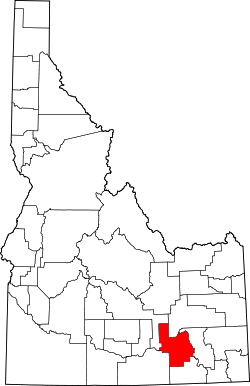Demographics
Historical population| Census | Pop. | Note | %± |
|---|
| 1920 | 5,105 | | — |
|---|
| 1930 | 4,457 | | −12.7% |
|---|
| 1940 | 3,965 | | −11.0% |
|---|
| 1950 | 3,988 | | 0.6% |
|---|
| 1960 | 4,111 | | 3.1% |
|---|
| 1970 | 4,864 | | 18.3% |
|---|
| 1980 | 6,844 | | 40.7% |
|---|
| 1990 | 7,086 | | 3.5% |
|---|
| 2000 | 7,538 | | 6.4% |
|---|
| 2010 | 7,817 | | 3.7% |
|---|
| 2020 | 7,878 | | 0.8% |
|---|
| 2024 (est.) | 8,381 | [7] | 6.4% |
|---|
|
2020 census
As of the 2020 census, the county had a population of 7,878. The median age was 35.3 years, with 30.2% of residents under the age of 18 and 16.3% aged 65 or older. For every 100 females there were 101.9 males, and for every 100 females age 18 and over there were 104.1 males age 18 and over. [13]
The racial makeup of the county was 65.8% White, 0.3% Black or African American, 2.8% American Indian and Alaska Native, 0.2% Asian, 0.1% Native Hawaiian and Pacific Islander, 21.8% from some other race, and 9.0% from two or more races. Hispanic or Latino residents of any race comprised 33.3% of the population. [14]
0.0% of residents lived in urban areas, while 100.0% lived in rural areas. [15]
There were 2,689 households in the county, of which 38.7% had children under the age of 18 living with them and 18.8% had a female householder with no spouse or partner present. About 20.9% of all households were made up of individuals and 9.9% had someone living alone who was 65 years of age or older. [13]
There were 2,937 housing units, of which 8.4% were vacant. Among occupied housing units, 73.9% were owner-occupied and 26.1% were renter-occupied. The homeowner vacancy rate was 1.7% and the rental vacancy rate was 5.9%. [13]
2010 census
As of the 2010 United States census, there were 7,817 people, 2,641 households, and 2,019 families living in the county. [16] The population density was 5.6 inhabitants per square mile (2.2/km2). There were 2,944 housing units at an average density of 2.1 units per square mile (0.81 units/km2). [17] The racial makeup of the county was 75.1% white, 2.3% American Indian, 0.4% Asian, 0.3% black or African American, 0.1% Pacific islander, 19.5% from other races, and 2.4% from two or more races. Those of Hispanic or Latino origin made up 29.8% of the population. [16] In terms of ancestry, 16.7% were German, 16.7% were English, and 7.2% were American. [18]
Of the 2,641 households, 40.7% had children under the age of 18 living with them, 60.6% were married couples living together, 10.1% had a female householder with no husband present, 23.6% were non-families, and 19.8% of all households were made up of individuals. The average household size was 2.94 and the average family size was 3.39. The median age was 33.2 years. [16]
The median income for a household in the county was $40,843 and the median income for a family was $46,391. Males had a median income of $35,674 versus $29,844 for females. The per capita income for the county was $18,412. About 8.3% of families and 11.1% of the population were below the poverty line, including 13.7% of those under age 18 and 12.3% of those age 65 or over. [19]
2000 census
As of the census [20] of 2000, there were 7,538 people, 2,560 households, and 1,968 families living in the county. The population density was 5 people per square mile (1.9 people/km2). There were 2,844 housing units at an average density of 2 units per square mile (0.77 units/km2). The racial makeup of the county was 83.78% White, 0.09% Black or African American, 3.29% Native American, 0.32% Asian, 0.04% Pacific Islander, 11.10% from other races, and 1.38% from two or more races. 21.73% of the population were Hispanic or Latino of any race. 18.0% were of German, 17.6% English and 10.9% American ancestry.
There were 2,560 households, out of which 40.90% had children under the age of 18 living with them, 63.40% were married couples living together, 8.80% had a female householder with no husband present, and 23.10% were non-families. 20.30% of all households were made up of individuals, and 8.80% had someone living alone who was 65 years of age or older. The average household size was 2.92 and the average family size was 3.38.
In the county, the population was spread out, with 33.80% under the age of 18, 8.40% from 18 to 24, 25.40% from 25 to 44, 22.00% from 45 to 64, and 10.40% who were 65 years of age or older. The median age was 32 years. For every 100 females, there were 101.00 males. For every 100 females age 18 and over, there were 99.90 males.
The median income for a household in the county was $32,226, and the median income for a family was $36,685. Males had a median income of $29,676 versus $20,930 for females. The per capita income for the county was $14,007. About 10.80% of families and 16.10% of the population were below the poverty line, including 20.10% of those under age 18 and 12.70% of those age 65 or over.
This page is based on this
Wikipedia article Text is available under the
CC BY-SA 4.0 license; additional terms may apply.
Images, videos and audio are available under their respective licenses.




